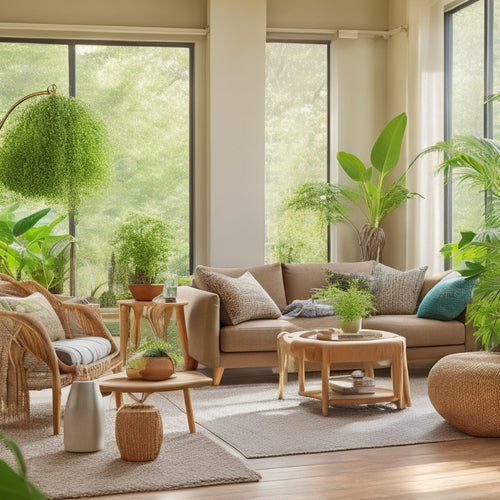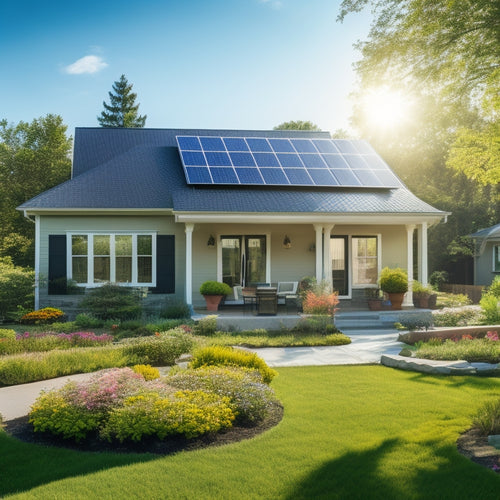Sorting With Sustainability: Eco-Friendly Organizing Made Easy
Share
You're taking the first step towards a more sustainable lifestyle by embracing eco-friendly organizing. By adopting mindful consumption habits, you'll reduce waste and create a more organized space that aligns with your values. Start by letting go of items that no longer serve a purpose, and practice intentional decision-making when it comes to what you keep and what you release. As you create space, you'll find opportunities to repurpose and upcycle old items, reducing waste and promoting creativity. As you continue on this journey, you'll discover more innovative ways to live in harmony with the planet.
Key Takeaways
• Adopt a mindful approach to decluttering, letting go of items that no longer serve a purpose to create space physically, mentally, and emotionally.
• Implement budgeting strategies, such as the 50/30/20 rule, to allocate funds wisely and avoid impulse buys that contribute to waste.
• Opt for eco-friendly storage solutions, like reusable containers and repurposed items, to reduce single-use plastics and promote sustainability.
• Transform discarded items into functional treasures through repurposing and upcycling to reduce waste and promote creativity.
• Switch to eco-friendly cleaning products and sustainable cleaning habits to reduce waste, improve indoor air quality, and create a healthier workspace.
Decluttering With a Clear Conscience
As you set out on the journey of decluttering with a clear conscience, start by acknowledging that every item you remove from your space is an opportunity to reduce waste and live more sustainably.
This mindset shift is essential in adopting a mindful approach to decluttering. By recognizing the impact of your actions, you'll be more intentional about what you choose to keep and what you let go of.
Practice mindful surrender by letting go of items that no longer serve you. This isn't about getting rid of everything, but about being intentional with what you keep.
As you release these items, practice compassionate release. Acknowledge the memories or emotions attached to each item, and gently let them go.
This process allows you to create space, not only in your physical environment but also in your mental and emotional landscapes.
Sustainable Storage Solutions Found
With your newly decluttered space, you're now ready to implement sustainable storage solutions that align with your values and promote a more organized, eco-friendly lifestyle. You're not just organizing your belongings, you're creating a space that reflects your commitment to the environment.
Eco Shelves: Made from reclaimed or sustainably sourced wood, eco shelves are a great alternative to traditional shelving units. Look for options with minimal waste and low-VOC (volatile organic compound) finishes.
Green Cabinets: Opt for cabinets made from recycled materials or those with a high percentage of post-consumer recycled content. You can also repurpose old cabinets or give new life to thrift store finds.
Reusable Containers: Swap single-use plastic bins for reusable containers made from sustainable materials like bamboo or recycled plastic. These can be used for storing items like clothes, toys, or office supplies.
Repurposing and Upcycling 101
You're probably familiar with the thrill of transforming an old, discarded item into something new and useful.
By repurposing and upcycling, you'll not only reduce waste but also breathe new life into items that would've otherwise ended up in landfills.
In this section, you'll discover creative reuse ideas to turn old into new again, and open up a world of possibilities where trash becomes treasure.
Old to New Again
Transforming discarded items into functional treasures, you'll discover the art of repurposing and upcycling, breathing new life into what would otherwise end up in landfills. This creative approach not only reduces waste but also gives you a sense of accomplishment and pride in your eco-friendly endeavors.
To get started, consider the following:
Vintage Revival
Scour thrift stores and grandma's attic for hidden gems, and give them a new purpose. That vintage suitcase can become a unique coffee table or storage unit.
Timeless Treasures
Identify items you no longer need but still have value. Upcycle them into functional pieces, such as turning old t-shirts into reusable bags or creating a planter from an old boot.
Creative Repurposing
Think outside the box (or item) and envision a new use for an old item. For instance, an old ladder can become a bookshelf or a room divider.
Creative Reuse Ideas
Now that you've mastered the art of giving old items a new lease on life, let's explore some creative reuse ideas that will take your repurposing skills to the next level.
You've already discovered the secret to transforming trash into treasure, and now it's time to get creative.
Imagine turning an old mason jar into a rustic candle holder or upcycling vintage windows into a unique room divider.
With creative reuse, the possibilities are endless. You'll experience a sense of Vintage Revival as you breathe new life into forgotten items.
This is where your imagination knows no bounds, and you'll discover a sense of Creative Freedom.
As you experiment with different materials and techniques, you'll find joy in reducing waste and creating something truly unique.
So, don't be afraid to think outside the box (or jar, or window...).
The more creative you are, the more sustainable your space will become.
Eco-Friendly Labeling Essentials
As you explore eco-friendly labeling essentials, you'll want to examine the type of labels you're using, what they're made of, and the ink that brings them to life.
You'll discover that reusable label options can substantially reduce waste, while the material used for labels can have a major impact on the environment.
Reusable Label Options
You can greatly reduce waste and minimize environmental impact by opting for reusable label options that can be easily updated and reused multiple times. This eco-friendly approach to labeling allows you to reduce your carbon footprint while maintaining a organized and clutter-free space.
Digital Labels: Create and print your own labels using a digital tool or app. This option eliminates the need for physical labels and reduces paper waste.
Chalkboard Labels: Use chalkboard labels that can be easily wiped clean and rewritten with a chalk marker. This option is perfect for labeling storage containers or shelves.
Whiteboard Labels: Similar to chalkboard labels, whiteboard labels can be easily erased and rewritten with a dry-erase marker. This option is great for labeling files, folders, or office supplies.
Label Material Matters
When selecting eco-friendly labels, the material you choose can substantially impact the environmental footprint of your labeling system. You have a range of options, but not all are created equal.
| Material | Eco-Friendliness |
| Recycled Paper | High |
| Bamboo Alternatives | High |
| Sugarcane-Based | Medium |
| Virgin Paper | Low |
For instance, recycled paper is a great choice, as it reduces waste and conserves natural resources. Bamboo alternatives are another excellent option, as bamboo is a highly renewable resource. If you're looking for a more affordable option, sugarcane-based labels are a decent choice, but keep in mind they may not be as eco-friendly as other options. As for virgin paper, it's best to avoid it, as it contributes to deforestation and habitat destruction. Additionally, consider using plant-based inks, which are biodegradable and non-toxic. By choosing the right material, you'll be well on your way to creating an eco-friendly labeling system that aligns with your values.
Eco-Ink Considerations
Your labeling system's eco-friendliness also depends on the type of ink used, so you must choose eco-inks that align with your sustainability goals. Traditional inks can be harmful to the environment, but there are alternatives that can reduce your carbon footprint.
Some eco-friendly ink options include:
- Soy-based inks: Made from soybeans, these inks are biodegradable and non-toxic.
- Vegetable-based inks: Derived from plant-based materials, these inks are a more sustainable option.
- Water-based inks: These inks are free from harsh chemicals and have a lower environmental impact.
When selecting an eco-friendly ink, look for eco certifications such as EcoLogo or ISO 14021, which guarantee the ink meets rigorous environmental standards. By choosing eco-inks, you can reduce your environmental impact and create a more sustainable labeling system.
Minimizing Waste in the Office
Every day, offices generate a staggering amount of waste, from discarded paper and broken pens to disposable coffee cups and redundant packaging materials.
As you aim to create a more sustainable workspace, minimizing waste and reducing your environmental footprint is crucial.
One effective way to achieve this is by implementing waste reduction strategies. Start by evaluating your supply chain to identify areas where you can reduce, reuse, or recycle materials.
Shifting to a paperless workflow and digital archiving can also greatly reduce waste and increase energy efficiency.
By making these simple changes, you'll not only reduce waste but also lower your energy consumption and carbon emissions.
Additionally, consider switching to eco-friendly office supplies and encouraging your team to adopt sustainable practices.
Conscious Consumption Strategies
As you aim to create a more sustainable office, adopting conscious consumption strategies becomes essential to reduce your environmental impact and promote a culture of responsibility. By making intentional purchasing decisions, you can substantially minimize waste and support eco-friendly practices.
Buy local: When possible, choose local vendors and suppliers to reduce carbon emissions from transportation. This also helps boost your local economy and fosters community engagement.
Adopt slow fashion: Instead of buying cheap, trendy items that quickly end up in landfills, invest in high-quality, timeless pieces that promote sustainability and reduce textile waste.
Prioritize quality over quantity: Focus on purchasing durable, long-lasting products that reduce the need for frequent replacements, thereby minimizing waste and conserving resources.
Green Cleaning for a Fresh Start
By switching to eco-friendly cleaning products and adopting sustainable cleaning habits, you can substantially reduce your office's environmental footprint and create a healthier workspace. This not only benefits the environment but also improves indoor air quality, reducing the risk of respiratory issues and allergic reactions.
Here are some eco-friendly cleaning swaps to get you started:
| Traditional Cleaning Product | Eco-Friendly Alternative | Benefits |
|---|---|---|
| Bleach-based disinfectants | Natural sanitizers (e.g., vinegar, hydrogen peroxide) | Non-toxic, gentle on surfaces |
| Single-use cleaning wipes | Reusable cloths with eco-friendly cleaning solutions | Reduces waste, saves money |
| Chemical-based all-purpose cleaners | Plant-based, biodegradable cleaners | Gentle on surfaces, better for the environment |
| Disposable cleaning bottles | Eco refills or concentrates with reusable containers | Reduces plastic waste, minimizes carbon footprint |
The Power of Second-Hand Finds
You can substantially reduce waste and support sustainable consumption by incorporating second-hand finds into your office setup, from refurbished furniture to pre-owned office supplies. This approach not only helps the environment but also adds a unique touch to your workspace.
Thrift stores are a great place to explore for hidden gems, from vintage office decor to gently used office supplies. You might stumble upon a vintage typewriter or a set of antique paperweights that add a touch of nostalgia to your space.
Online marketplaces like eBay, Craigslist, or Facebook Marketplace often feature second-hand office equipment and furniture at affordable prices. Be cautious when transacting online and verify you're buying from a reputable seller.
Visit local flea markets or garage sales to discover one-of-a-kind office decor and supplies. Keep an eye out for unique, high-quality items that reflect your personal style and add a touch of vintage vibes to your workspace.
Mindful Purchasing for Organizers
Carefully selecting organizers that align with your sustainable goals guarantees a clutter-free workspace that not only boosts productivity but also supports eco-friendly practices.
As you begin your organizing journey, adopting mindful purchasing habits that promote sustainability is crucial. Start by setting a budget and sticking to it – this will help you avoid impulse buys and reduce waste.
Implementing budgeting strategies like the 50/30/20 rule can help you allocate your funds wisely.
When shopping for organizers, consider seasonal shopping to reduce the carbon footprint associated with transportation. For instance, purchase summer storage bins during end-of-season sales to reuse them the following year.
Additionally, opt for multi-purpose organizers that can serve multiple functions, reducing the need for single-use items.
DIY Organization Hacks Gone Green
As you set out on your DIY organization journey, you'll want to get creative with repurposed containers that reduce waste and promote sustainability.
You'll find that old mason jars, cardboard tubes, and fabric scraps can be transformed into functional storage solutions.
Repurposed Containers
Transforming discarded containers into functional organizers not only reduces waste but also adds a touch of creativity to your space. You can breathe new life into old items, giving them a second chance to shine. This eco-friendly approach to organizing not only helps the environment but also adds a touch of personality to your space.
Vintage Finds: Upcycle old mason jars, wooden crates, or metal tins to create unique storage containers. Add a touch of rustic charm to your space with these one-of-a-kind organizers.
Urban Renewal: Think beyond traditional storage bins and use old cardboard boxes, plastic containers, or fabric scraps to create functional organizers. Get creative with paint, glue, and other craft supplies to give them a fresh look.
Eclectic Mix: Combine different materials like glass, wood, and fabric to create a unique organizer that reflects your personal style. Mix and match different textures, colors, and shapes to add visual interest to your space.
Eco-Friendly Labeling Tips
You can take your repurposed containers to the next level by labeling them with eco-friendly methods that align with your sustainable organizing goals. This is where the magic happens, and your DIY organization hacks really start to pay off. By using eco-friendly labeling methods, you'll not only reduce waste but also create a visually appealing system that's easy to navigate.
To create an effective label design, consider the following tips:
| Labeling Method | Eco-Friendly Benefits |
|---|---|
| Chalkboard Labels | Reusable and erasable, reducing paper waste |
| Plant-Based Ink | Non-toxic and biodegradable, reducing environmental impact |
| Recycled Paper Labels | Made from post-consumer waste, reducing landfill waste |
| Color Coding | Reduces the need for excessive labeling, promoting simplicity |
Maintaining an Eco-Friendly Space
By implementing a few simple habits into your daily routine, you can substantially reduce waste and maintain an eco-friendly space that not only benefits the environment but also enhances your overall well-being.
To start, focus on incorporating eco-friendly decor into your space. Opt for sustainable materials, repurpose old items, and choose energy-efficient lighting to create a harmonious and environmentally conscious atmosphere.
Three green habits to maintain your eco-friendly space:
-
Reduce paper clutter: Switch to digital documents and bills, and recycle any unnecessary paper waste.
-
Use eco-friendly cleaning products: Choose products with natural ingredients and biodegradable packaging to reduce chemical waste.
-
Conduct regular decluttering sessions: Set aside time each week to sort through items, donate or repurpose what you can, and responsibly dispose of the rest.
Frequently Asked Questions
Can I Still Achieve a Minimalist Look With Sustainable Decor?
You can absolutely achieve a minimalist look with sustainable decor by striking an aesthetic balance between simplicity and intentional design choices, incorporating natural hues to create a calming atmosphere that exudes serenity.
Are Eco-Friendly Storage Options More Expensive Than Traditional Ones?
You'll find that eco-friendly storage options can be pricier upfront, but consider the long-term benefits: sustainable materials, reduced waste, and a clear conscience. Compare costs, and factor in the value of responsible material sourcing.
How Do I Balance Sustainability With the Need for Convenience?
"To balance sustainability with convenience, you'll overcome eco-guilt by making convenient swaps, incorporating sustainable habits into daily routines, and prioritizing small changes that add up to make a big impact."
Can I Repurpose Items From Thrift Stores or Garage Sales?
You can repurpose items from thrift stores or garage sales, and turn them into unique upcycled decor pieces, giving old items a new life while reducing waste, and making your space truly one-of-a-kind.
Do Eco-Friendly Cleaning Products Really Work as Well as Traditional Ones?
You'll be relieved to know that eco-friendly cleaning products can be just as effective as traditional ones, thanks to effective ingredients and reputable green certifications like EcoLogo or Safer Choice, ensuring a cleaner home and conscience.
Related Posts
-

Solar Power Systems for Cost-Effective Sustainability
Investing in solar power systems is a smart move for cost-effective sustainability. You can save about $1,500 annuall...
-

Eco-Friendly Home Design Ideas for Beginners
If you're starting your eco-friendly home design expedition, focus on sustainable materials like recycled wood or rec...
-

Affordable Solar Panels for Home Use
Affordable solar panels offer you a smart way to cut down on energy costs while promoting sustainability. With govern...


